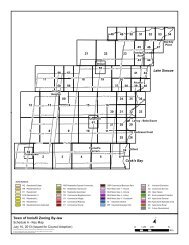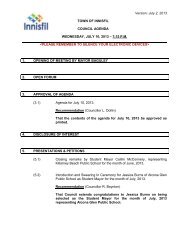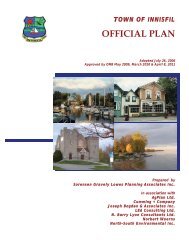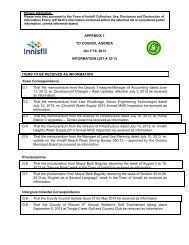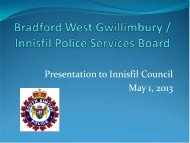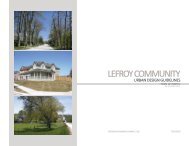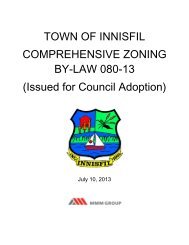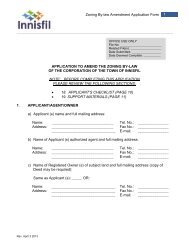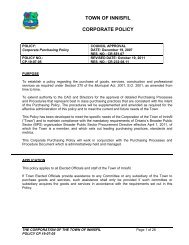Draft Secondary Plan Policies - Town of Innisfil
Draft Secondary Plan Policies - Town of Innisfil
Draft Secondary Plan Policies - Town of Innisfil
You also want an ePaper? Increase the reach of your titles
YUMPU automatically turns print PDFs into web optimized ePapers that Google loves.
i) demonstrates general conformity with the recommendations <strong>of</strong> the Alcona North MasterDrainage <strong>Plan</strong>;ii) identifies where deviations are warranted, if any;iii) provides supporting technical analyses for appropriate location, sizing and design <strong>of</strong>proposed storm water management facilities;iv) provides further detail on water quality objectives set out under the Lake SimcoeProtection <strong>Plan</strong>;v) assesses downstream erosion criteria;vi) provides further detail on the recommended means to reduce downstream as set out inthe Master Drainage <strong>Plan</strong> and means <strong>of</strong> implementation by the developmentcommunity;viii) demonstrates how an integrated treatment train approach will be used to minimizestormwater management flows and reliance on end-<strong>of</strong>-pipe controls;ix) demonstrates how anticipated changes in the water balance between predevelopmentand post-development will be minimized, andiix) demonstrates how anticipated changes in phosphorous loadings between predevelopmentand post-development will be minimized.15.9.3 Master Hydrogeological Studya) A Master Hydrogeological Study shall be prepared, to the satisfaction <strong>of</strong> the <strong>Town</strong> inconsultation with the LSRCA, for the entirety <strong>of</strong> the <strong>Secondary</strong> <strong>Plan</strong> Area. It shall besubmitted for approval prior to submission <strong>of</strong> draft plan <strong>of</strong> subdivision applications and shallbe based on terms <strong>of</strong> reference approved by the <strong>Town</strong> in consultation with the LSRCA,which addresses, but is not limited to, the following matters:i) a pre and post development water budget based on the land use plan;ii) analysis <strong>of</strong> the impacts <strong>of</strong> soil compaction on groundwater recharge;iii) identification <strong>of</strong> infiltration areas and areas contributing to infiltration areas;iv) identification <strong>of</strong> mitigation measures to maintain pre-development infiltration anddischarge including an assessment <strong>of</strong> how the use <strong>of</strong> infiltration areas can bemaximized in the design <strong>of</strong> the draft plans <strong>of</strong> subdivision;v) assessment <strong>of</strong> potential dewatering requirements;vi) identification and evaluation <strong>of</strong> methods and mechanisms that work towardsmaintaining the hydrologic function to ensure the sustenance <strong>of</strong> and no negative impactto the adjacent provincially significant wetland;vii) assessment <strong>of</strong> the impact on the water table <strong>of</strong> other natural heritage features, as wellas base flow to watercourses and means to mitigate the impacts;viii) further assessment <strong>of</strong> the aquifer vulnerability in the secondary plan area in the context<strong>of</strong> the observed elevated nitrate level in the deep monitor BH6-1 and recommendationsfor reducing or eliminating the potential for groundwater contamination;ix) recommendations for a monitoring programme to address monitoring during and afterconstruction; andx) assessment <strong>of</strong> risk to the Stroud Municipal Wells for the northwestern edge <strong>of</strong> thesubject lands based on the land uses proposed for that area.January 2012 19





